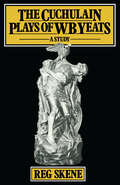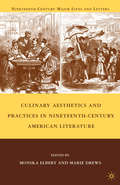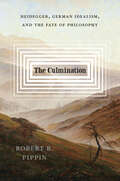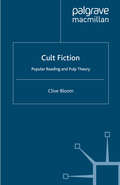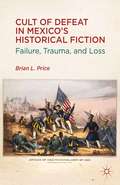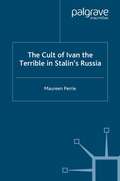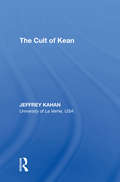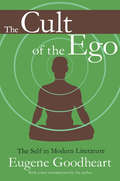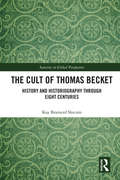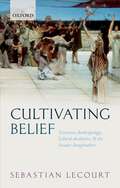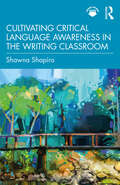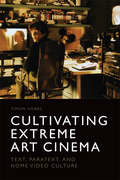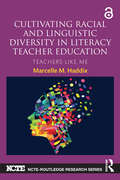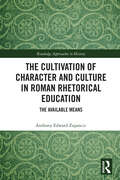- Table View
- List View
Cuentos
by Charles PerraultUn gato que se las trae; Pulgarcito, un niño tan pequeño como valeroso; una Caperucita Roja que se deja engañar ingenuamente; la hermosa Cenicienta y sus envidiosas hermanastras... son los principales personajes cuyas aventuras y desventuras se narran en estos cuentos inmortales.
Culinary Aesthetics and Practices in Nineteenth-Century American Literature (Nineteenth-Century Major Lives and Letters)
by M. Drews M. ElbertCulinary Aesthetics and Practices in Nineteenth-Century American Literature examines the preponderance of food imagery in nineteenth-century literary texts. Contributors to this volume analyze the social, political, and cultural implications of scenes involving food and dining and illustrate how "aesthetic" notions of culinary preparation are often undercut by the actual practices of cooking and eating. As contributors interrogate the values and meanings behind culinary discourses, they complicate commonplace notions about American identity and question the power structure behind food production and consumption.
The Culmination: Heidegger, German Idealism, and the Fate of Philosophy
by Robert PippinA provocative reassessment of Heidegger’s critique of German Idealism from one of the tradition’s foremost interpreters. Heidegger claimed that Western philosophy ended—failed, even—in the German Idealist tradition. In The Culmination, Robert B. Pippin explores the ramifications of this charge through a masterful survey of Western philosophy, especially Heidegger’s critiques of Hegel and Kant. Pippin argues that Heidegger’s basic concern was to determine sources of meaning for human life, particularly those that had been obscured by Western philosophy’s attention to reason. The Culmination offers a new interpretation of Heidegger, German Idealism, and the fate of Western rationalism.
The Culmination: Heidegger, German Idealism, and the Fate of Philosophy
by Robert PippinA provocative reassessment of Heidegger’s critique of German Idealism from one of the tradition’s foremost interpreters. Heidegger claimed that Western philosophy ended—failed, even—in the German Idealist tradition. In The Culmination, Robert B. Pippin explores the ramifications of this charge through a masterful survey of Western philosophy, especially Heidegger’s critiques of Hegel and Kant. Pippin argues that Heidegger’s basic concern was to determine sources of meaning for human life, particularly those that had been obscured by Western philosophy’s attention to reason. The Culmination offers a new interpretation of Heidegger, German Idealism, and the fate of Western rationalism.
Cult Fiction: Popular Reading and Pulp Theory
by C. BloomHere is an exploration of pulp literature and pulp mentalities: an investigation into the nature and theory of the contemporary mind in art and in life. Here too, the violent, the sensational and the erotic signify different facets of the modern experience played out in the gaudy pages of kitsch literature. Clive Bloom offers the reader a chance to investigate the underworld of literary production and from it find a new set of co-ordinates for questions regarding publishing and reading practices in America and Britain, ideas of genre, problems related to commercial production, concerns regarding high and low culture, the canon and censorship, as well as a discussion of the rhetoric of current critical debate. Concentrating on remembered authors as well as many long disregarded or forgotten, Cult Fiction provides a theory of kitsch art that radically alters our perceptions of literature and literary values whilst providing a panorama of an almost forgotten history: the history of pulp.
Cult of Defeat in Mexico’s Historical Fiction: Failure, Trauma, and Loss
by B. PriceCult of Defeat in Mexico's Historical Fiction: Failure, Trauma, and Loss examines recent Mexican historical novels that highlight the mistakes of the nineteenth century for the purpose of responding to present crises.
The Cult of Ivan the Terrible in Stalin's Russia (Studies in Russian and East European History and Society)
by M. PerrieIvan IV, the sixteenth-century Russian tsar notorious for his reign of terror, became an unlikely national hero in the Soviet Union during the 1940s. This book traces the development of Ivan's positive image, placing it in the context of Stalin's campaign for patriotism. In addition to historians' images of Ivan, the author examines literary and artistic representations, including Sergei Eisenstein's famous film, banned for its depiction of the tsar which was interpreted as an allegorical criticism of Stalin.
The Cult of Kean
by Jeffrey KahanA Shakespearean actor who made his career on the public stage, whose sex life was known and discussed in Britain, America and France, Edmund Kean has inspired numerous writings, many biographies among them. But until now, no work has tackled the complicated and fascinating story of his literary appropriation, both in his own day and after his death. Dealing with the way a variety of canonical authors-including Byron, Coleridge, Keats, Dumas, Twain and Sartre-appropriated Kean through the centuries, The Cult of Kean traces a remarkable literary legacy. In each chapter Jeffrey Kahan discusses how many of history's greatest figures viewed Kean, and how these figures examined and discussed themselves in relation to-or projected themselves onto-a variety of constructions of the great actor. Kahan first explores the rise of Kean in light of rising democratic sympathies, then in light of Kean's equally autocratic dealings with playwrights, among them John Keats. He looks at Kean's sexual shenanigans at Drury Lane, exploring them in the wider social context of infidelity; and explores perceptions of Kean in America, during his 1820-1 and 1825-6 tours. The Cult of Kean cites many letters from Kean's mother and still others from his wife, none of which have been published previously. The study also features rare and interesting paintings of Kean, as well as depictions of how writers, actors and film makers continue to add to his remarkable literary legacy.
The Cult of Kean
by Jeffrey KahanA Shakespearean actor who made his career on the public stage, whose sex life was known and discussed in Britain, America and France, Edmund Kean has inspired numerous writings, many biographies among them. But until now, no work has tackled the complicated and fascinating story of his literary appropriation, both in his own day and after his death. Dealing with the way a variety of canonical authors-including Byron, Coleridge, Keats, Dumas, Twain and Sartre-appropriated Kean through the centuries, The Cult of Kean traces a remarkable literary legacy. In each chapter Jeffrey Kahan discusses how many of history's greatest figures viewed Kean, and how these figures examined and discussed themselves in relation to-or projected themselves onto-a variety of constructions of the great actor. Kahan first explores the rise of Kean in light of rising democratic sympathies, then in light of Kean's equally autocratic dealings with playwrights, among them John Keats. He looks at Kean's sexual shenanigans at Drury Lane, exploring them in the wider social context of infidelity; and explores perceptions of Kean in America, during his 1820-1 and 1825-6 tours. The Cult of Kean cites many letters from Kean's mother and still others from his wife, none of which have been published previously. The study also features rare and interesting paintings of Kean, as well as depictions of how writers, actors and film makers continue to add to his remarkable literary legacy.
The Cult of the Ego: The Self in Modern Literature
by Eugene GoodheartGoethe once remarked that "every emancipation of the spirit is pernicious unless there is a corresponding growth of control." This remark may be taken as a motto for Eugene Goodheart's study of an aspect of the cultural history of the past two hundred years. In separate chapters on Rousseau, Stendhal, Goethe and Carlyle, Dostoevsky, Whitman, Lawrence, and Joyce, Goodheart discovers a community of concern which he calls the cult of the ego. All these writers examined here in one way or another deal with "the emancipation of the spirit" with all its promise and danger. The characteristic attempt is to "extend the boundaries of the self by going beyond the area of safety" and. thereby risking even the destruction of the self. They advance the claims of the self at the same time seeking the controls that will secure these claims. The artist-hero becomes the central figure in Goodheart's volume, since it is he who comes to exemplify the possibilities of the cult of the ego. Their efforts, Goodheart argues, have ambiguous results. The seeds of contemporary nihilism are in the failures of these writers to master the chaos of egoism, which they helped engender. But their heroism was partly in the effort of resistance: moral, religious, aesthetic. In a large portion of modern literature, resistance has been abandoned either out of exhaustion or out of fascination with the destructive tendency of modern life: in Beckett's phrase, "a world endlessly collapsing." In his introduction to this first paperback edition, Goodheart discusses the book's origin in relation to the counter-cultural unrest of 1968 when it was first published and weighs its theme of the emancipated self against current postmodern assertions of the "death of the author." The Cult of the Ego is written with admirable clarity and economy. Its interests are literary, moral and political. Moving freely and knowledgeably among various national literatures, Goodheart has made an original and valuable contribution to the field of comparative literature. Eugene Goodheart is Edytha Macy Gross Professor of Humanities Emeritus at Brandeis University. Among his books are Novel Practices: Classic Modern Fiction, Modernism and the Critical Spirit, Culture and the Radical Conscience, and Confessions of a Secular Jew: A Memoir, all available from Transaction.
The Cult of the Ego: The Self in Modern Literature
by Eugene GoodheartGoethe once remarked that "every emancipation of the spirit is pernicious unless there is a corresponding growth of control." This remark may be taken as a motto for Eugene Goodheart's study of an aspect of the cultural history of the past two hundred years. In separate chapters on Rousseau, Stendhal, Goethe and Carlyle, Dostoevsky, Whitman, Lawrence, and Joyce, Goodheart discovers a community of concern which he calls the cult of the ego. All these writers examined here in one way or another deal with "the emancipation of the spirit" with all its promise and danger. The characteristic attempt is to "extend the boundaries of the self by going beyond the area of safety" and. thereby risking even the destruction of the self. They advance the claims of the self at the same time seeking the controls that will secure these claims. The artist-hero becomes the central figure in Goodheart's volume, since it is he who comes to exemplify the possibilities of the cult of the ego. Their efforts, Goodheart argues, have ambiguous results. The seeds of contemporary nihilism are in the failures of these writers to master the chaos of egoism, which they helped engender. But their heroism was partly in the effort of resistance: moral, religious, aesthetic. In a large portion of modern literature, resistance has been abandoned either out of exhaustion or out of fascination with the destructive tendency of modern life: in Beckett's phrase, "a world endlessly collapsing." In his introduction to this first paperback edition, Goodheart discusses the book's origin in relation to the counter-cultural unrest of 1968 when it was first published and weighs its theme of the emancipated self against current postmodern assertions of the "death of the author." The Cult of the Ego is written with admirable clarity and economy. Its interests are literary, moral and political. Moving freely and knowledgeably among various national literatures, Goodheart has made an original and valuable contribution to the field of comparative literature. Eugene Goodheart is Edytha Macy Gross Professor of Humanities Emeritus at Brandeis University. Among his books are Novel Practices: Classic Modern Fiction, Modernism and the Critical Spirit, Culture and the Radical Conscience, and Confessions of a Secular Jew: A Memoir, all available from Transaction.
The Cult of Thomas Becket: History and Historiography through Eight Centuries (Sanctity in Global Perspective)
by Kay Brainerd SlocumOn 29 December, 1170, Thomas Becket, Archbishop of Canterbury, was brutally murdered in his own cathedral. News of the event was rapidly disseminated throughout Europe, generating a widespread cult which endured until the reign of Henry VIII in the sixteenth century, and engendering a fascination which has lasted until the present day. The Cult of Thomas Becket: History and Historiography through Eight Centuries contributes to the lengthy debate surrounding the saint by providing a historiographical analysis of the major themes in Becket scholarship, tracing the development of Becket studies from the writings of the twelfth-century biographers to those of scholars of the twenty-first century. The book offers a thorough commentary and analysis which demonstrates how the Canterbury martyr was viewed by writers of previous generations as well as our own, showing how they were influenced by the intellectual trends and political concerns of their eras, and indicating how perceptions of Thomas Becket have changed over time. In addition, several chapters are devoted a discussion of artworks in various media devoted to the saint, as well as liturgies and sermons composed in his honor. Combining a wide historical scope with detailed textual analysis, this book will be of great interest to scholars of medieval religious history, art history, liturgy, sanctity and hagiography.
The Cult of Thomas Becket: History and Historiography through Eight Centuries (Sanctity in Global Perspective)
by Kay Brainerd SlocumOn 29 December, 1170, Thomas Becket, Archbishop of Canterbury, was brutally murdered in his own cathedral. News of the event was rapidly disseminated throughout Europe, generating a widespread cult which endured until the reign of Henry VIII in the sixteenth century, and engendering a fascination which has lasted until the present day. The Cult of Thomas Becket: History and Historiography through Eight Centuries contributes to the lengthy debate surrounding the saint by providing a historiographical analysis of the major themes in Becket scholarship, tracing the development of Becket studies from the writings of the twelfth-century biographers to those of scholars of the twenty-first century. The book offers a thorough commentary and analysis which demonstrates how the Canterbury martyr was viewed by writers of previous generations as well as our own, showing how they were influenced by the intellectual trends and political concerns of their eras, and indicating how perceptions of Thomas Becket have changed over time. In addition, several chapters are devoted a discussion of artworks in various media devoted to the saint, as well as liturgies and sermons composed in his honor. Combining a wide historical scope with detailed textual analysis, this book will be of great interest to scholars of medieval religious history, art history, liturgy, sanctity and hagiography.
Cultivating Belief: Victorian Anthropology, Liberal Aesthetics, and the Secular Imagination
by Sebastian LecourtThis book explores how a group of Victorian liberal writers that included George Eliot, Walter Pater, and Matthew Arnold became attracted to new theories of religion as a function of race and ethnicity. Since the early modern period, British liberals had typically constructed religion as a zone of personal belief that defined modern individuality and interiority. During the 1860s, however, Eliot, Arnold, and other literary liberals began to claim that religion could actually do the most for the modern self when it came as a kind of involuntary inheritance. Stimulated by the emerging science of anthropology, they imagined that religious experiences embedded in race or ethnicity could render the self heterogeneous, while the individual who insisted upon selecting his or her own beliefs would become narrow and parochial. By rethinking the grounds of religion, this book argues, these writers were ultimately trying to shift liberal individualism away from a classical Protestant liberalism that celebrated interiority and agency and toward one that valorized eclecticism and the capacity to keep multiple values in play. More broadly, their work offers us a new picture of secularization, not as a process of religious decline, but as the reinscription of religion as an ordinary feature of human life—like art, or politics, or sex—whose function could be debated.
Cultivating Belief: Victorian Anthropology, Liberal Aesthetics, and the Secular Imagination
by Sebastian LecourtThis book explores how a group of Victorian liberal writers that included George Eliot, Walter Pater, and Matthew Arnold became attracted to new theories of religion as a function of race and ethnicity. Since the early modern period, British liberals had typically constructed religion as a zone of personal belief that defined modern individuality and interiority. During the 1860s, however, Eliot, Arnold, and other literary liberals began to claim that religion could actually do the most for the modern self when it came as a kind of involuntary inheritance. Stimulated by the emerging science of anthropology, they imagined that religious experiences embedded in race or ethnicity could render the self heterogeneous, while the individual who insisted upon selecting his or her own beliefs would become narrow and parochial. By rethinking the grounds of religion, this book argues, these writers were ultimately trying to shift liberal individualism away from a classical Protestant liberalism that celebrated interiority and agency and toward one that valorized eclecticism and the capacity to keep multiple values in play. More broadly, their work offers us a new picture of secularization, not as a process of religious decline, but as the reinscription of religion as an ordinary feature of human life—like art, or politics, or sex—whose function could be debated.
Cultivating Critical Language Awareness in the Writing Classroom
by Shawna ShapiroThis book introduces Critical Language Awareness (CLA) Pedagogy as a robust and research-grounded framework to engage and support students in critical examinations of language, identity, privilege and power.Starting with an accessible introduction to CLA, chapters cover key topics—including World Englishes, linguistic prejudice, news media literacy, inclusive language practices, and more—in an inviting and thought-provoking way to promote reflection and analysis. Part I provides an overview of the foundations of CLA pedagogy, while Part II highlights four instructional pathways for CLA pedagogy: Sociolinguistics, Critical Academic Literacies, Media/Discourse Analysis, and Communicating Across Difference. Each pathways chapter is structured around Essential Questions and Transferrable Skills, and includes three thematic learning sequences. Part III offers tools and guidance for tailoring CLA pedagogy to the reader’s own teaching context and to students’ individual needs. The volume’s wealth of resources and activities are a pedagogical toolkit for supporting and embracing linguistic diversity in the classroom. The cohesive framework, concrete strategies, engaging activities, and guiding questions in this volume allow readers to come away with not only a deeper understanding of CLA, but also a clear roadmap for implementing CLA pedagogy in the classroom. Synthesizing relevant research from educational linguistics and writing studies, this book is ideal for courses in English/literacy education, college composition, L2 writing instruction, and educational linguistics.
Cultivating Critical Language Awareness in the Writing Classroom
by Shawna ShapiroThis book introduces Critical Language Awareness (CLA) Pedagogy as a robust and research-grounded framework to engage and support students in critical examinations of language, identity, privilege and power.Starting with an accessible introduction to CLA, chapters cover key topics—including World Englishes, linguistic prejudice, news media literacy, inclusive language practices, and more—in an inviting and thought-provoking way to promote reflection and analysis. Part I provides an overview of the foundations of CLA pedagogy, while Part II highlights four instructional pathways for CLA pedagogy: Sociolinguistics, Critical Academic Literacies, Media/Discourse Analysis, and Communicating Across Difference. Each pathways chapter is structured around Essential Questions and Transferrable Skills, and includes three thematic learning sequences. Part III offers tools and guidance for tailoring CLA pedagogy to the reader’s own teaching context and to students’ individual needs. The volume’s wealth of resources and activities are a pedagogical toolkit for supporting and embracing linguistic diversity in the classroom. The cohesive framework, concrete strategies, engaging activities, and guiding questions in this volume allow readers to come away with not only a deeper understanding of CLA, but also a clear roadmap for implementing CLA pedagogy in the classroom. Synthesizing relevant research from educational linguistics and writing studies, this book is ideal for courses in English/literacy education, college composition, L2 writing instruction, and educational linguistics.
Cultivating Extreme Art Cinema: Text, Paratext and Home Video Culture
by Simon HobbsThe first textbook on Scottish legal history from the genesis of Scots law to the 1707 Union, written from a legal perspective
Cultivating Extreme Art Cinema: Text, Paratext and Home Video Culture
by Simon HobbsA lively hands-on introduction to the use of electronic corpora in the description and analysis of English
Cultivating Racial and Linguistic Diversity in Literacy Teacher Education: Teachers Like Me (NCTE-Routledge Research Series)
by Marcelle M. HaddixCultivating Racial and Linguistic Diversity in Literacy Teacher Education examines how English and literacy teacher education—a space dominated by White, English-monolingual, middle class perspectives—shapes the experiences of preservice teachers of color and their construction of a teacher identity.Significant and timely, this book focuses attention on the unique needs and perspectives of racially and linguistically diverse preservice teachers in the field of literacy and English education and offers ways to improve teacher training to better meet the needs of preservice teachers from all racial, ethnic, and linguistic backgrounds. These changes have the potential to diversify the teacher force and cultivate teachers who bring rich racial, cultural, and linguistic histories to the field of teaching.Chapters 1, 2, and 3 of this book are freely available as downloadable Open Access PDFs at http://www.taylorfrancis.com under a Creative Commons Attribution-Non Commercial-No Derivatives (CC-BY-NC-ND) 4.0 license.
Cultivating Racial and Linguistic Diversity in Literacy Teacher Education: Teachers Like Me (NCTE-Routledge Research Series)
by Marcelle M. HaddixCultivating Racial and Linguistic Diversity in Literacy Teacher Education examines how English and literacy teacher education—a space dominated by White, English-monolingual, middle class perspectives—shapes the experiences of preservice teachers of color and their construction of a teacher identity.Significant and timely, this book focuses attention on the unique needs and perspectives of racially and linguistically diverse preservice teachers in the field of literacy and English education and offers ways to improve teacher training to better meet the needs of preservice teachers from all racial, ethnic, and linguistic backgrounds. These changes have the potential to diversify the teacher force and cultivate teachers who bring rich racial, cultural, and linguistic histories to the field of teaching.Chapters 1, 2, and 3 of this book are freely available as downloadable Open Access PDFs at http://www.taylorfrancis.com under a Creative Commons Attribution-Non Commercial-No Derivatives (CC-BY-NC-ND) 4.0 license.
Cultivation and Catastrophe: The Lyric Ecology of Modern Black Literature (The <I>Callaloo</I> African Diaspora Series)
by Sonya PosmentierAt the intersection of social and environmental history there has emerged a rich body of black literary response to natural and agricultural experiences, whether the legacy of enforced agricultural labor or of the destruction and displacement brought about by a hurricane. In Cultivation and Catastrophe, Sonya Posmentier uncovers a vivid diasporic tradition of black environmental writing that responds to the aftermath of plantation slavery, urbanization, and free and forced migrations. While humanist discourses of African American and postcolonial studies often sustain a line between nature and culture, this book instead emphasizes the relationship between them, offering an innovative environmental history of modern black literature. Posmentier argues that environmental experiences of growth and rupture define the literature of black freedom, an archive that ranges from sonnets, mini-epics, documentary poems, periodicals, and novels to blues songs, dancehall productions, and ethnographic writing. In turn, this literature generates important and surprising models for ecological thought. Claude McKay, for example, connects rows of potatoes to the poetic line; Zora Neale Hurston composes rhythmic communal lyrics in the Florida "muck" following a deadly hurricane; and Derek Walcott critiques property-based ecological relations through the archipelagic shape of his mid-career poetry. Posmentier examines how these writers, along with Gwendolyn Brooks, Bessie Smith, Sterling Brown, Lloyd Lovindeer, Kamau Brathwaite, and others give voice to racialized experiences of alienation from the land while simultaneously envisioning a modern poetics of survival, repair, and generation. Going against the grain of scholarship that has situated modern black diasporic agency largely in metropolitan sites, Posmentier traces a black literary history of environmental and social disaster while exploring the possibilities and limits of poetry as an archive for black modern culture in its many forms. This pathbreaking book offers stunning new insight into modern black literature, environmental humanities, and poetry and poetics.
Cultivation and Catastrophe: The Lyric Ecology of Modern Black Literature (The <I>Callaloo</I> African Diaspora Series)
by Sonya PosmentierAt the intersection of social and environmental history there has emerged a rich body of black literary response to natural and agricultural experiences, whether the legacy of enforced agricultural labor or of the destruction and displacement brought about by a hurricane. In Cultivation and Catastrophe, Sonya Posmentier uncovers a vivid diasporic tradition of black environmental writing that responds to the aftermath of plantation slavery, urbanization, and free and forced migrations. While humanist discourses of African American and postcolonial studies often sustain a line between nature and culture, this book instead emphasizes the relationship between them, offering an innovative environmental history of modern black literature. Posmentier argues that environmental experiences of growth and rupture define the literature of black freedom, an archive that ranges from sonnets, mini-epics, documentary poems, periodicals, and novels to blues songs, dancehall productions, and ethnographic writing. In turn, this literature generates important and surprising models for ecological thought. Claude McKay, for example, connects rows of potatoes to the poetic line; Zora Neale Hurston composes rhythmic communal lyrics in the Florida "muck" following a deadly hurricane; and Derek Walcott critiques property-based ecological relations through the archipelagic shape of his mid-career poetry. Posmentier examines how these writers, along with Gwendolyn Brooks, Bessie Smith, Sterling Brown, Lloyd Lovindeer, Kamau Brathwaite, and others give voice to racialized experiences of alienation from the land while simultaneously envisioning a modern poetics of survival, repair, and generation. Going against the grain of scholarship that has situated modern black diasporic agency largely in metropolitan sites, Posmentier traces a black literary history of environmental and social disaster while exploring the possibilities and limits of poetry as an archive for black modern culture in its many forms. This pathbreaking book offers stunning new insight into modern black literature, environmental humanities, and poetry and poetics.
The Cultivation of Character and Culture in Roman Rhetorical Education: The Available Means (Routledge Approaches to History)
by Anthony Edward ZupancicAt its very center, The Cultivation of Character and Culture in Roman Rhetorical Education: The Available Means is a study of the subtle, organic ways that rhetoric can work to cultivate a particular character. This is an extension of the current work in composition studies, which focus on the ways that writing instruction contributes to the development of individual power and agency in students, combined with an ancient understanding of the ways that students learned to act within a particular, accepted cultural framework. It recognizes and reclaims a lost dimension of rhetoric, a dimension that is conceptually linked to the martial culture of the ancient world, to show how ancient rhetorical theory framed the discipline as an education in thinking, speaking, and acting in ways that were necessary to be both a persuasive speaker and an effective leader. Through close readings and analysis of particular rhetorical exercises, the book shows how rhetorical education shaped characters that were appropriate in the eyes of the dominant culture but were also capable of working independently to progressively alter that culture. In showing the ways that rhetorical education shaped a particular character, the book demonstrates the ways that the combination character, culture, and virtue are vital to leadership in any time.
